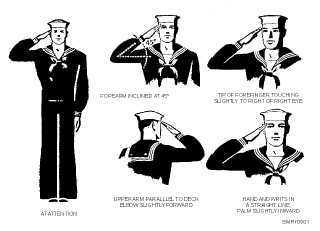NOTE
The salute should not be ended as though the
person is waving to someone or trying to get
something off the fingers. Navy custom
permits left-hand saluting when a salute
cannot be rendered with the right hand. Army
and Air Force customs permit only right-hand
salutes.
Under naval customs, the hand salute is
accompanied by a word of greeting. The junior stands at
attention, looks the senior straight in the eye, and says
(depending upon the time of day) the following:
From first rising until noon “Good morning, …”
From noon until sunset “Good afternoon, …”
From sunset until turning in “Good evening, …”
It is preferable to call the senior by grade and name;
that is, “Commander Jones,” rather than by the
impersonal “sir” or “ma’am.”
The following are some of the major points you
should remember when rendering a salute:
1. If possible, always use your right hand. Use your
left hand only if your right hand is injured. Use your left
hand to carry objects and to leave your right hand free to
salute.
2. Accompany your salute with a cheerful,
respectful greeting; for example, “Good morning, sir”;
“Good afternoon, Commander [Jones]”; “Good
evening, Chaplain [Smith]”.
3. Always salute from the position of attention. If
you are walking, you need not stop; but hold yourself
erect and square. If on the double, slow to a walk when
saluting.
4. Look directly into the officer’s eyes as you
salute.
5. If you are carrying something in both hands and
cannot render the hand salute, look at the officer as
though you were saluting and render a verbal greeting as
previously described.
6. Remove a pipe, cigar, or cigarette from your
mouth or hand before you salute.
7. Salute officers even if they are uncovered or
their hands are occupied. Your salute will be
acknowledged by a verbal greeting, such as “Good
morning,” “Good afternoon,” or something similar.
8. Army and Air Force policy, unlike the Navy’s, is
to salute when uncovered. Suppose you are in an office
with several Army personnel, and all of you are
uncovered. An officer enters and the soldiers rise and
salute. You should do likewise; to do otherwise would
make you seem ill-mannered or disrespectful.
9. If you are walking with or standing by a
commissioned officer and the occasion for a salute
arises, do not salute until the officer salutes. Assume
that you are walking with a lieutenant. A commander
approaches. Do not salute the commander until the
lieutenant salutes; but as soon as the lieutenant starts to
salute, you should quickly do the same.
10. When approaching an officer, start your salute
far enough away from the officer to allow time for your
salute to be seen and returned. This space can vary; but a
distance of about six paces is considered good for this
purpose. Hold your salute until it is returned or until you
are six paces past the officer.
11. Salute all officers who are close enough to be
recognized as officers. It is unnecessary to identify an
officer by name; however, ensure that he/she is wearing
the uniform of an officer.
9-3
Student Notes:
Figure 9-1.—Hand salute.

